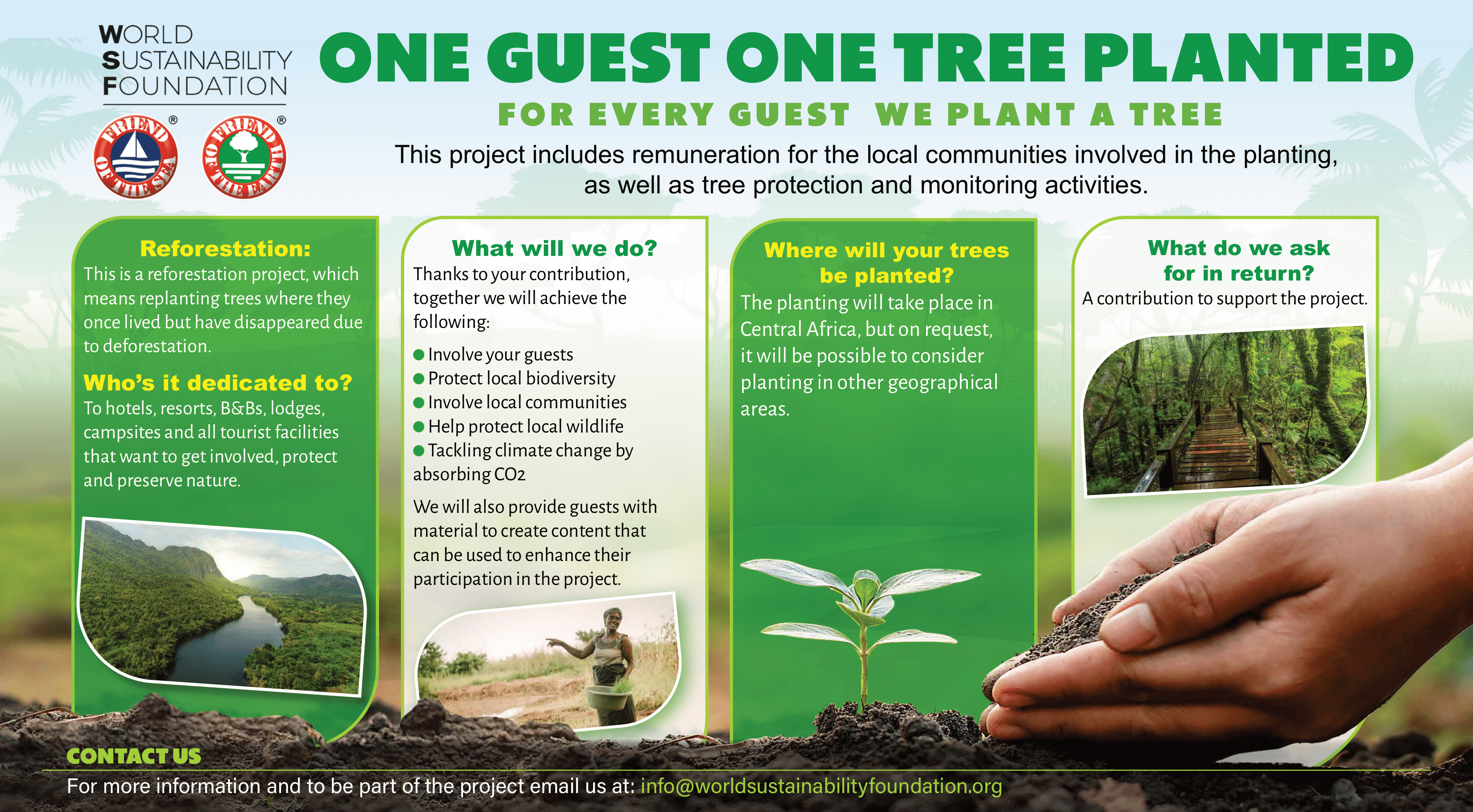Save the Forests
One Guest – One Tree Planted
We created a brand new project whose goal is to plant a tree for every guest of tourist facilities such as hotels, resorts, B&Bs, campsites, etc.

Why are forests so important?
Download and read our report on the importance of forests and the problem of deforestation.
Not travelling?
Click here to Plant your Tree and support the reforestation project from afar.
Tree Planting Locations: Where Are We Planting
Central Africa
The trees are planted in any of the following countries: Mali, Senegal, Tanzania, Uganda, or Kenya.
This specific project is in collaboration with Trees for the Future.
Find out how many trees we have planted in collaboration with them.
It is estimated that 1,000 trees absorb about roughly 36 Metric Tonnes of CO2 over 20 years, contributing to the fight against climate change.
Dozens of people from local communities are involved in planting and monitoring efforts, earning compensation for their valuable contributions.
Indonesia
Based in Semarang (Central Java), this project improves biodiversity, the environment and the lives of farmers in local communities through tree planting and education. Community forestry is used in this project, which is recognised as a key strategy to promote Sustainable Forest management and reduce poverty in rural areas of developing countries. Tens of thousands of local families have been involved in this project.
These are the species we are planting:
– Toona sureni
– Parkia speciosa
– Syzygium aromaticum
– Tectona grandis
The goal is to plant around 25,000 of the above-mentioned trees.
Find out more about the forest we are creating here.
Find out who adhered
Campaign
Sustainable Forest Management (SFM) is defined as “the stewardship and use of forests and forest lands in a way, and at a rate, that maintains their biodiversity, productivity, regeneration capacity, vitality, and their potential to fulfill, now and in the future, relevant ecological, economic and social functions, at local, national, and global levels, and that does not cause damage to other ecosystems” (Forest Europe 2016; Mackey et al. 2015).
The Problem
Trends in the proportion of land area under forests is used as one of the indicators for the Millennium Development Goals (United Nations, 2008).
We are losing forests at a rate of 27 football fields a minute. That is a startling number. But the biggest problem for the world’s forests is not the outright clearing of forests, known as deforestation. It is degradation. Degraded forests are a problem, as they reduce their efficiency in keeping air and water clean, in providing wildlife with shelter and food, or in capturing carbon.
Key drivers for the loss of biodiversity and changes to forest ecosystems are:
- Land-use change, especially through agriculture expansion, is the most destructive driver for the loss of the natural world on land, followed by the extraction and overexploitation of species like timber harvests and hunting.
The indirect drivers which are driving an unprecedented rate of global change in nature are:
- Growing human population
- Global economy
- Trade driving demand for energy and materials
- The wrong economic incentives with insufficient recognition of the values of ecosystem functions.

Environmental Consequences
The decades of exploitation have destroyed and degraded much of the Earth’s natural forests. We’ve already lost half of our forested land globally. Across the planet from the Amazon to Canada and Indonesia large areas are being degraded, due in large part to unsustainable industrial activities.
The United Nations biodiversity report warns that most of the global 2020 targets for the protection of nature outlined in the Strategic Plan for Biodiversity (Aichi biodiversity targets) will not be met, undermining half of the UN’s Sustainable Development Goals (SDGs).
Possible Solutions
Conservation of forest ecosystems can be approached in many ways. The possible solutions are categorized in three ways through which forest conservation can be achieved from a local to a global level:
- Through the recovery and promotion of knowledge and traditional methodologies,
- Through conservation and protected areas,
- Through governmental initiatives.
WSF Activities and initiatives
The World Sustainability Foundation Friend of the Earth project provides financial support to Trees for the Future (TREES), a USA non-profit that is currently working with thousands of farming families across nine countries in sub-Saharan Africa.
Decades of unsustainable agriculture practices have resulted in degraded and unproductive land, nutrient-scarce food systems, and farming families who are unable to grow and sell enough to meet their most basic needs. Using the Forest Garden Approach in semi-arid countries like Senegal, Trees for the Future has proven that agroforestry is a solution to each of these challenges, effectively ending hunger and poverty while restoring the land and environment.
The aim of our collaboration is to plant a total number of 4.000 trees in Cameroon, Chad, and Mali.
Call to action
Everybody can contribute to preserving Forests by:
- Choosing Friend of the Earth certified products from sustainable agriculture and farming
- Sign Friend of the Earth Change.org petitions
- Advocate for forest preservation locally and to maintain flora biodiversity.
















